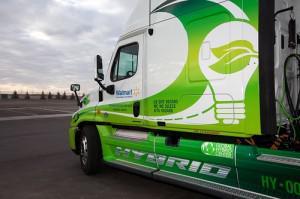 On the heels of the recent increase in Corporate Average Fuel Economy (CAFE) standards for automobiles, the Obama Administration has announced the inaugural fuel efficiency standards for large trucks and buses. Up until this point, there have not been any fuel efficiency and greenhouse gas pollution standards for work trucks, buses, and other heavy duty vehicles. These changes were first discussed last year when the Environmental Protection Agency proposed similar standards for light and heavy duty trucks.
On the heels of the recent increase in Corporate Average Fuel Economy (CAFE) standards for automobiles, the Obama Administration has announced the inaugural fuel efficiency standards for large trucks and buses. Up until this point, there have not been any fuel efficiency and greenhouse gas pollution standards for work trucks, buses, and other heavy duty vehicles. These changes were first discussed last year when the Environmental Protection Agency proposed similar standards for light and heavy duty trucks.
According to the Department of Transportation,
Long haul trucks will save an average of 4 gallons for fuel for every 100 miles traveled. Heavy-duty pickups and vehicles like buses, delivery trucks, or vans would save one gallon for every 100 miles traveled. Altogether, we’re looking at saving a projected 530 million barrels of oil. That is a huge benefit to truck owners and operators. Over the life of a new truck built to fit these standards, a semi-truck driver will see a net savings of $73,000 through reduced fuel costs.
The Obama administration estimates that the standards will save American businesses roughly $50 billion in fuel costs over the duration. These savings “are on top of the $1.7 trillion that American families will save at the pump from the historic fuel-efficiency standards announced by the Obama Administrations for cars and light duty trucks, including the model year 2017-2025 agreement announced by the President last month.” The projected savings for trucks and buses built between 2014 and 2018 will be more than half a billion barrels of oil and more than a quarter of a billion metric tons of greenhouse gases.
The press release, cited above, provides the following figures:
- By the 2018 model year, the program is expected to achieve significant savings relative to current levels, across vehicle types. Certain combination tractors – commonly known as big-rigs or semi-trucks – will be required to achieve up to approximately 20 percent reduction in fuel consumption and greenhouse gas emissions by model year 2018, saving up to 4 gallons of fuel for every 100 miles traveled.
- For heavy-duty pickup trucks and vans, separate standards are required for gasoline-powered and diesel trucks. These vehicles will be required to achieve up to approximately 15 percent reduction in fuel consumption and greenhouse gas emissions by model year 2018. Under the finalized standards a typical gasoline or diesel powered heavy-duty pickup truck or van could save one gallon of fuel for every 100 miles traveled.
- Vocational vehicles – including delivery trucks, buses, and garbage trucks – will be required to reduce fuel consumption and greenhouse gas emissions by approximately 10 percent by model year 2018. These trucks could save an average of one gallon of fuel for every 100 miles traveled.
Increased (and new) fuel efficiency programs will also make manufacturers more competitive on the global market. As the price of oil fluctuates, hedging against its inevitable rise will be important for businesses. For more information on the history of the CAFE standards, which were first enacted in 1975, check out the National Highway Traffic and Safety Administration.
[Image source]

